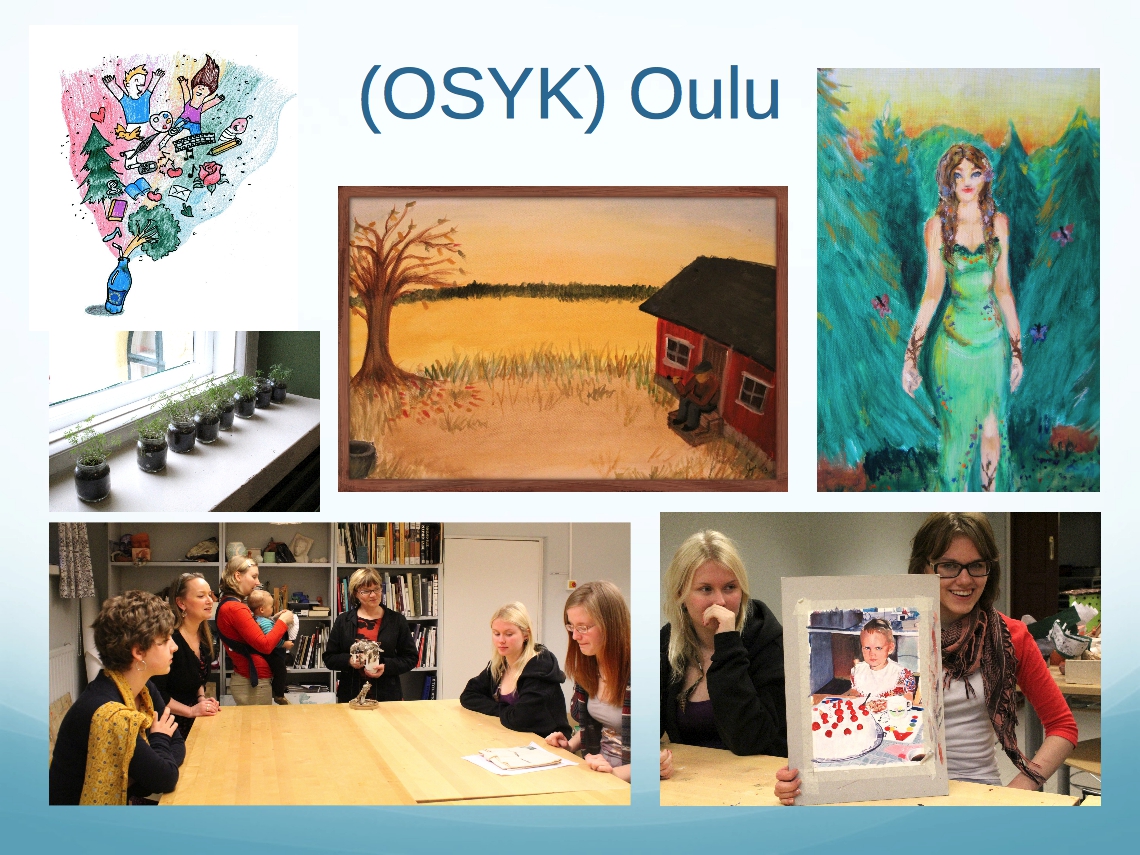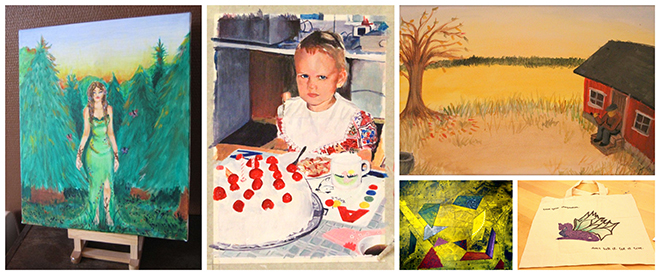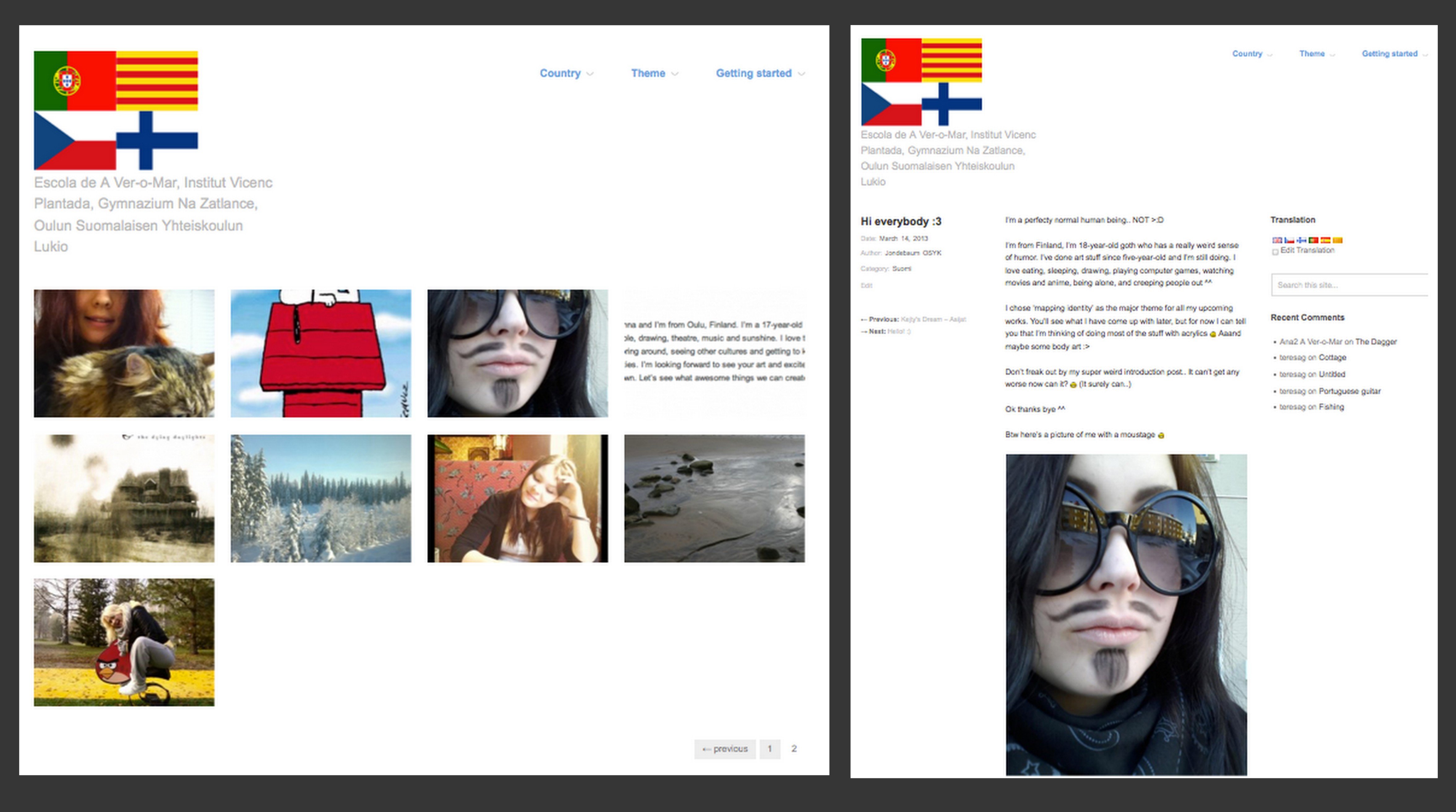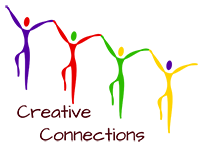Oulun Suomalaisen Yhteiskoulun Lukio (upper secondary school) - Finland
Region: Osyk, Oulu
Other schools in the Quad Blog: Escola de A Ver-o-Mar (Portugal), Gymnazium Na Zatlance (Czech), Institut Vicenç Plantada (Spain)
Creative Connections Project: My Europe and a personal art project

Oulun Suomalaisen Yhteiskoulun Lukio is a big urban upper secondary school in Oulu city centre and is one of the three upper secondary schools in Oulu. The school specialises in Arts and Theatre (the other two schools in music and science.) Most of the students who participated in the Creative Connections project had participated earlier in a contemporary art workshop course. The school has many ongoing international projects (traditionally with youth and drama education) and the teacher also had a long experience in participating in Comenius co-operations.
Special
The Creative Connections project was offered to the school's students as an optional course in contemporary arts. So the students participating were volunteers and knew about the blogging. A special addition was a Canadian exchange student who participated in the project and gave another perspective to European citizenship.
The students worked independently and there were meetings arranged about every two weeks to follow each other’s progress. Their assignment was to plan, document and execute their own art project and present the process and the final work on the Quad Blog. Initially they looked at the Connected Gallery and chose one of the categories as a starting point for their own artwork.
Teacher comment
The difference to others must have been that I haven't seen any of the students working, because they did this course independently. In the meetings I could see at which phase they were going and from the blog I could see the pictures, but I didn't see the concrete works before the end and then only some of them.
The chosen projects
- Introduction post
- My Europe
- A Personal Art Project: idea, sketch, work in progress, finished work.
The work and blogging centred on the student’s personal art project, which students were to do during the spring term for the project. The introduction post was the initial way of starting the blogging and test how the online environment of the Creative Connections website worked. The students also saw that introducing themselves was a natural way to start. My Europe was an assignment given in the project and it was felt initially that this was irrelevant without the connection to the main task, but ended up raising interesting views and vivid discussions between the students. My Europe image was developed as a small drawing and presented to the group for comments and discussion.
The personal art project started with enthusiasm with great ideas and plans. During the spring term, due to other projects and duties that the students had, the time and energy was decreased and students had to be more realistic about their input in the project. So in the end the artworks were quite moderate in size and the students settled on traditional techniques that they were more familiar with.

The Use of the Connected Gallery
The Connected Gallery was a starting point and a basis for the work in Oulu. The students choose a category as a starting point for their own artwork. The students were encouraged to look through the artworks for inspiration and as examples. Most of the students selected category A, Mapping Identity or B, Mapping Nation. They selected the categories since they wanted to work with a personal topic or to show a part of their home town or everyday life to others. Several topics also dealt with Finnish cultural conventions. In the end, the category might have changed and E, Action, was included.
Teacher comment
I wanted to give a quite free starting point. So that it is, just like the image database, that you go and maybe search for a theme from there. We did go through all the images and spread them on the tables and introduced all the categories, and then had some free conversation about what arose from them.
The two selected artworks from the database were discussed and analysed in pairs during one meeting. This initial task was based on Markku Laakso’s Coffee Break and Jaakko Heikkilä’s photograph Mirja by the River as one of the Czech researchers wanted the Finnish view on these pieces of art. Some of the students had already participated in a workshop course on contemporary art which influenced their concept of art, the way they planned their project and saw the possibilities of using different art techniques.
Blogging
Student comment
Well, maybe my principle thought was that they show their own work and so I show them also mine. That, I’m not going to start comparing, like oh that is so good, because anyway the starting points are so different. So it’s more like sharing. That we have got the common package, that here you are, from which you can get inspiration and what comes from that.
The blogging was started in February 2012 on the first researcher’s visit. Most of the students were skilled computer users and some of them even had experience in blogging. However, the help of the researcher was needed in sorting out some passwords for logging in (the list of all users and starting passwords was very useful, since there were some mistakes in email addresses and the students had not received the link and password).
The students seemed also very comfortable in writing in English and did not need any help in translation. They had experience of automatic machine translation and did not want to leave their (Finnish) texts in the machine’s ‘hands’. One of the students presented an example of the machine translation from Facebook, which has a built-in button for translation. The example was a document on the student's Facebook page that had been accidentally translated from Finnish to English. She found the result hilarious. Because of the international context, communicating in English was self-evident for the students.
Student comment
I will write it in English, so I will leave it in English because it’s weird to write in Finnish for foreign people.
At the same time a few students found the blogging environment difficult to navigate and needed support to get started. They had less experience and interest in using computers. Everyone found the system complicated.
Student comment
If I think about for example Tumblr, it’s much more practical in a way. That came up so grown up like. It has been somehow composed that way, and the colours and all. It comes to my mind that it’s some company’s intra web or something. And then it’s little... It can be understood with common sense. That you can get things put in there and I did manage to do that, but it needed some work, that where is what. So it wasn’t clear.
The positive thing with the blogging was the need to reflect on and make clear their aims, ideas and processes of the artwork in the posts. The students also remarked that their written texts gave more scope to their images.
Student comment:
Well, at least I thought, that if I would just put there an image, that here it is, I wouldn’t give anything. Because I think the purpose is also to tell, that how we have got here, that what was the idea, when you started to do it. So if you just put the image there, it’s just an image and there’s nothing else. So you maybe don’t get that many dimensions.
About Identity and European Citizen Themes
Besides the introduction to the artworks, categories and blogging, which the students made at the start part of the ‘My Europe’ project, the students also put in visual form their vision of Europe as A5 drawings. The special perspective to the discussions around presenting the images was given by the Canadian exchange student in the group.
The main art projects dealt with identity in general, both the students’ own identity and the Finnish national identity. There was a lot of discussion about national Finnish poetry, national epic, landscape and ancient religion. The students also wondered how these topics and images would be perceived in the partner countries.
An interesting view of Europe was given by a Canadian exchange student in the group. She saw Europeans as the people who came to North America and did tremendous damage to the native culture and nature, but also saw the complexity of the situation since the same people were her Scottish and French ancestors. She also remarked that all of her education was based on Europe. Her stay in Finland had opened the eyes to the simplicity of European identity; Finnish people know where they are from and what is Finnish. To answer what is Canadian is more difficult than that due to the diversity, it’s “mosaic”.
Student comment
There is something mysterious in Europe. The birthplace of philosophy and all... Everything I know now started across the sea.
The view of seeing the Europeans as the ‘bad guys’ amazed the other students and led to a discussion about the history and the image Europeans have of North America, USA and Canada. The image that they had about North American attitudes towards Europe was from TV series and Movies, where going to Paris or London was something special for Americans; ‘the dream to go to Europe.’
Student comment
Super interesting. No one other, of the Europeans, from the other schools in this project will see it that way. Since we live here, we have concentrated on the positive things.
So the assignment opened a discussion on perspectives and identities that would not have been said otherwise. A further point to be considered is what did the exchange student process during her stay about European connectedness?
Student 1 Well if we talk about the reality, it hasn’t felt like having real...cooperation..
Student 2 Contact
Student 1 Either myself, I haven’t really dared to comment, I haven’t...
Student 2 At least we haven’t seen them, in sort of concrete way, and they haven’t. Have they posted there any photos of themselves?
Student 1 No.
Student 2 That would have been fun, I don’t know if any way possible, that kind of course where there would have been the possibility to see/meet them concretely, those persons. Then it might have been much easier to start to comment and there would have been certainly a different feeling.
Summary
The students had done several art courses in the upper secondary school of Osyk and for the Creative Connections project they were offered a voluntary art course. The Connected Gallery was presented as a place for inspiration and demonstration of the different forms and roles of contemporary art that the students could use to plan their own projects.
Teacher comment
There were 20 enthusiastic students starting, but at the end of the spring there was only handful of them left, who then did the project carefully and also blogged about the different stages. So the ones who actually participated, I think succeeded and got the profits of the project and discussed about the categories.

Through the spring term, the students had innovative ideas and enthusiasm, but in the end because of the other projects and busy exams, the participating group got smaller and the projects more realistic. In the end many of the students made their works with watercolours and acrylic paints instead of the original plans of environmental artworks, installations and videos. Still the original ideas they wanted to communicate stayed the same.
Teacher comment
Only thing was the problems with the blog and clearly some of the students dropped out because of these technical issues. But we had great conversations around the blog. And students made some comments on the works, but since they were ready at the end of the spring, the time period was short. It would have been nice to have a longer time to continue that kind of natural communication. The thing the students criticized was the lack of personal level in the communication. They didn't really know who the others were.
The blogging was found interesting, but the complicated system and the lack of real sense of the other students online, made the experience a little bit disappointing. What the project gave to the students was a wider perspective on contemporary art and cultural sensitivity. The blogging created a need for students to learn to explain their works, the ideas and process so that the viewers on the other side would understand their images. They had to process their own identity, the Finnish identity and culture, and also the contexts where the images were presented for the other partner countries and consider others' points of view and reactions.


